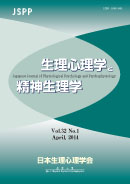All issues

Volume 32 (2014)
- Issue 3 Pages 139-
- Issue 2 Pages 43-
- Issue 1 Pages 1-
Volume 32, Issue 3
Displaying 1-4 of 4 articles from this issue
- |<
- <
- 1
- >
- >|
-
Tokihiro OGAWA, Izumi MATSUDA, Michiko TSUNEOKA2014Volume 32Issue 3 Pages 139-147
Published: December 31, 2014
Released on J-STAGE: June 14, 2016
Advance online publication: July 23, 2015JOURNAL FREE ACCESSCharacteristic physiological responses on the concealed information test (CIT) have been a topic of interest. The present study compared physiological responses and self-reported emotion between a single relevant item and a multiple relevant items condition. Participants performed a mock theft where they were asked to steal one or three accessories. They were also asked to choose one or three cards, each indicating a color name. If participants stole one accessory, they would choose three cards; if participants stole three accessories, they would choose one card. Then, participants underwent the CIT, which assessed stolen items and selected colors. The relevant-irrelevant differences in physiological measures, such as skin conductance, respiratory speed, heart rate, and normalized pulse volume, were smaller in the three-relevant items condition than in the one-relevant item condition. Self-reported measures indicated that participants felt surprise and tension during the relevant item presentation. However, the number of relevant items in the question set did not affect self-reported emotion. These results indicate dissociation between physiological and self-reported measures on the CIT.View full abstractDownload PDF (631K)
-
Tatsuya HIRAI2014Volume 32Issue 3 Pages 149-155
Published: December 31, 2014
Released on J-STAGE: June 14, 2016
Advance online publication: November 18, 2014JOURNAL FREE ACCESSEffects of aging on feedback processing when learning a reaching task were assessed by feedback-related negativity (FRN) and the frontal N1 of event-related potentials (ERPs). Younger (n=26, mean age 24 years) and older adults (n=20, mean age 71 years) performed an arm-reaching movement to reach for a target button located at the center of a console of 49 buttons (7×7) hidden by a feedback board. Participants were provided with visual feedback on their success or failure. Results indicated lower success rates for older than for younger adults. There were no age-related difference in FRN, whereas N1 was enhanced in older adults irrespective of success, or failure feedback. The enhancement of N1 suggests that older participants paid more attention to compensate for their impairment in feedback processing ability.View full abstractDownload PDF (613K)
-
Yukihiro SAWADA, Yuichi KATO2014Volume 32Issue 3 Pages 157-172
Published: December 31, 2014
Released on J-STAGE: June 14, 2016
Advance online publication: April 03, 2015JOURNAL FREE ACCESSNormalized pulse volume (NPV) is expressed as PGac/PGdc. Here, PGac and PGdc are the alternate and direct current components of the finger photo-plethysmogram (PG), respectively. In the present review, using a theoretical pressure-volume curve, we first examined the effects of increases in vascular resistance and elevations of blood pressure on these PG indices during rest and mental stress. It was confirmed that NPV was directly proportional to the pulsating component of the arterial blood volume, whereas PGac and PGdc were hemodynamically much more complicated. Notably, as a stress marker, NPV was predicted to be more sensitive than the other two indices. Next, the effects on these PG indices (especially, on NPV) during mental stress and rest, with both cases occurring under a threatening situation, were examined. Finger raising was suggested to make the Law of Initial Values work moderately by reducing the increases in vascular resistance even during the threatened mental stress. Reservations concerning the use of NPV in basics and applications are discussed.View full abstractDownload PDF (986K)
-
Hiroshi NITTONO2014Volume 32Issue 3 Pages 173-176
Published: December 31, 2014
Released on J-STAGE: June 14, 2016
Advance online publication: February 26, 2015JOURNAL FREE ACCESSDownload PDF (486K)
- |<
- <
- 1
- >
- >|